Boi Faltings
A Proposal for Networks Capable of Continual Learning
Mar 28, 2025Abstract:We analyze the ability of computational units to retain past responses after parameter updates, a key property for system-wide continual learning. Neural networks trained with gradient descent lack this capability, prompting us to propose Modelleyen, an alternative approach with inherent response preservation. We demonstrate through experiments on modeling the dynamics of a simple environment and on MNIST that, despite increased computational complexity and some representational limitations at its current stage, Modelleyen achieves continual learning without relying on sample replay or predefined task boundaries.
CopyJudge: Automated Copyright Infringement Identification and Mitigation in Text-to-Image Diffusion Models
Feb 21, 2025Abstract:Assessing whether AI-generated images are substantially similar to copyrighted works is a crucial step in resolving copyright disputes. In this paper, we propose CopyJudge, an automated copyright infringement identification framework that leverages large vision-language models (LVLMs) to simulate practical court processes for determining substantial similarity between copyrighted images and those generated by text-to-image diffusion models. Specifically, we employ an abstraction-filtration-comparison test framework with multi-LVLM debate to assess the likelihood of infringement and provide detailed judgment rationales. Based on the judgments, we further introduce a general LVLM-based mitigation strategy that automatically optimizes infringing prompts by avoiding sensitive expressions while preserving the non-infringing content. Besides, our approach can be enhanced by exploring non-infringing noise vectors within the diffusion latent space via reinforcement learning, even without modifying the original prompts. Experimental results show that our identification method achieves comparable state-of-the-art performance, while offering superior generalization and interpretability across various forms of infringement, and that our mitigation method could more effectively mitigate memorization and IP infringement without losing non-infringing expressions.
Continually Learning Structured Visual Representations via Network Refinement with Rerelation
Feb 19, 2025Abstract:Current machine learning paradigm relies on continuous representations like neural networks, which iteratively adjust parameters to approximate outcomes rather than directly learning the structure of problem. This spreads information across the network, causing issues like information loss and incomprehensibility Building on prior work in environment dynamics modeling, we propose a method that learns visual space in a structured, continual manner. Our approach refines networks to capture the core structure of objects while representing significant subvariants in structure efficiently. We demonstrate this with 2D shape detection, showing incremental learning on MNIST without overwriting knowledge and creating compact, comprehensible representations. These results offer a promising step toward a transparent, continually learning alternative to traditional neural networks for visual processing.
Agential AI for Integrated Continual Learning, Deliberative Behavior, and Comprehensible Models
Jan 28, 2025Abstract:Contemporary machine learning paradigm excels in statistical data analysis, solving problems that classical AI couldn't. However, it faces key limitations, such as a lack of integration with planning, incomprehensible internal structure, and inability to learn continually. We present the initial design for an AI system, Agential AI (AAI), in principle operating independently or on top of statistical methods, designed to overcome these issues. AAI's core is a learning method that models temporal dynamics with guarantees of completeness, minimality, and continual learning, using component-level variation and selection to learn the structure of the environment. It integrates this with a behavior algorithm that plans on a learned model and encapsulates high-level behavior patterns. Preliminary experiments on a simple environment show AAI's effectiveness and potential.
Directed Structural Adaptation to Overcome Statistical Conflicts and Enable Continual Learning
Dec 05, 2024Abstract:Adaptive networks today rely on overparameterized fixed topologies that cannot break through the statistical conflicts they encounter in the data they are exposed to, and are prone to "catastrophic forgetting" as the network attempts to reuse the existing structures to learn new task. We propose a structural adaptation method, DIRAD, that can complexify as needed and in a directed manner without being limited by statistical conflicts within a dataset. We then extend this method and present the PREVAL framework, designed to prevent "catastrophic forgetting" in continual learning by detection of new data and assigning encountered data to suitable models adapted to process them, without needing task labels anywhere in the workflow. We show the reliability of the DIRAD in growing a network with high performance and orders-of-magnitude simpler than fixed topology networks; and demonstrate the proof-of-concept operation of PREVAL, in which continual adaptation to new tasks is observed while being able to detect and discern previously-encountered tasks.
Copyright-Aware Incentive Scheme for Generative Art Models Using Hierarchical Reinforcement Learning
Oct 26, 2024Abstract:Generative art using Diffusion models has achieved remarkable performance in image generation and text-to-image tasks. However, the increasing demand for training data in generative art raises significant concerns about copyright infringement, as models can produce images highly similar to copyrighted works. Existing solutions attempt to mitigate this by perturbing Diffusion models to reduce the likelihood of generating such images, but this often compromises model performance. Another approach focuses on economically compensating data holders for their contributions, yet it fails to address copyright loss adequately. Our approach begin with the introduction of a novel copyright metric grounded in copyright law and court precedents on infringement. We then employ the TRAK method to estimate the contribution of data holders. To accommodate the continuous data collection process, we divide the training into multiple rounds. Finally, We designed a hierarchical budget allocation method based on reinforcement learning to determine the budget for each round and the remuneration of the data holder based on the data holder's contribution and copyright loss in each round. Extensive experiments across three datasets show that our method outperforms all eight benchmarks, demonstrating its effectiveness in optimizing budget distribution in a copyright-aware manner. To the best of our knowledge, this is the first technical work that introduces to incentive contributors and protect their copyrights by compensating them.
RLCP: A Reinforcement Learning-based Copyright Protection Method for Text-to-Image Diffusion Model
Sep 02, 2024



Abstract:The increasing sophistication of text-to-image generative models has led to complex challenges in defining and enforcing copyright infringement criteria and protection. Existing methods, such as watermarking and dataset deduplication, fail to provide comprehensive solutions due to the lack of standardized metrics and the inherent complexity of addressing copyright infringement in diffusion models. To deal with these challenges, we propose a Reinforcement Learning-based Copyright Protection(RLCP) method for Text-to-Image Diffusion Model, which minimizes the generation of copyright-infringing content while maintaining the quality of the model-generated dataset. Our approach begins with the introduction of a novel copyright metric grounded in copyright law and court precedents on infringement. We then utilize the Denoising Diffusion Policy Optimization (DDPO) framework to guide the model through a multi-step decision-making process, optimizing it using a reward function that incorporates our proposed copyright metric. Additionally, we employ KL divergence as a regularization term to mitigate some failure modes and stabilize RL fine-tuning. Experiments conducted on 3 mixed datasets of copyright and non-copyright images demonstrate that our approach significantly reduces copyright infringement risk while maintaining image quality.
Nuance Matters: Probing Epistemic Consistency in Causal Reasoning
Aug 27, 2024Abstract:To address this gap, our study introduces the concept of causal epistemic consistency, which focuses on the self-consistency of Large Language Models (LLMs) in differentiating intermediates with nuanced differences in causal reasoning. We propose a suite of novel metrics -- intensity ranking concordance, cross-group position agreement, and intra-group clustering -- to evaluate LLMs on this front. Through extensive empirical studies on 21 high-profile LLMs, including GPT-4, Claude3, and LLaMA3-70B, we have favoring evidence that current models struggle to maintain epistemic consistency in identifying the polarity and intensity of intermediates in causal reasoning. Additionally, we explore the potential of using internal token probabilities as an auxiliary tool to maintain causal epistemic consistency. In summary, our study bridges a critical gap in AI research by investigating the self-consistency over fine-grained intermediates involved in causal reasoning.
A Logical Fallacy-Informed Framework for Argument Generation
Aug 07, 2024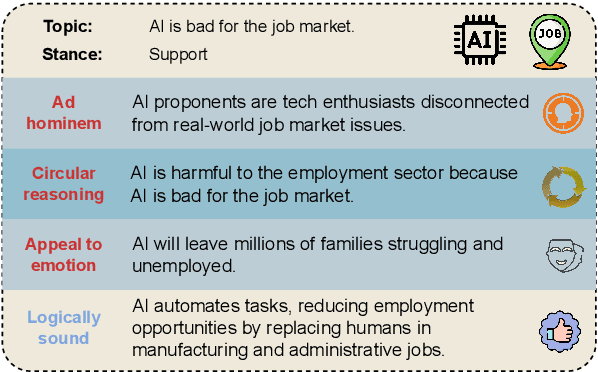

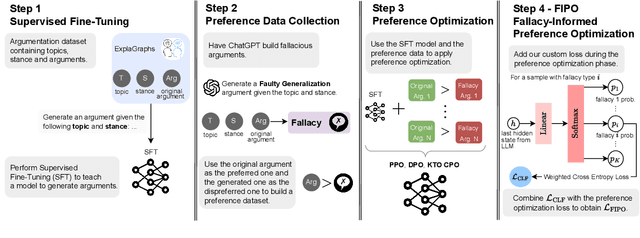
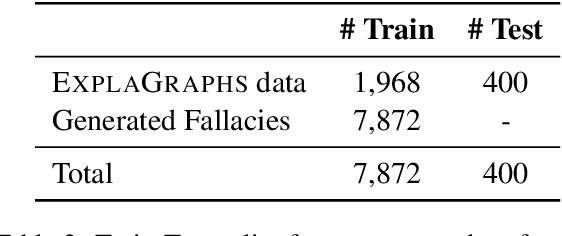
Abstract:Despite the remarkable performance of Large Language Models (LLMs), they still struggle with generating logically sound arguments, resulting in potential risks such as spreading misinformation. An important factor contributing to LLMs' suboptimal performance in generating coherent arguments is their oversight of logical fallacies. To address this issue, we introduce FIPO, a fallacy-informed framework that leverages preference optimization methods to steer LLMs toward logically sound arguments. FIPO includes a classification loss, to capture the fine-grained information on fallacy categories. Our results on argumentation datasets show that our method reduces the fallacy errors by up to 17.5%. Furthermore, our human evaluation results indicate that the quality of the generated arguments by our method significantly outperforms the fine-tuned baselines, as well as prior preference optimization methods, such as DPO. These findings highlight the importance of ensuring models are aware of logical fallacies for effective argument generation.
Could ChatGPT get an Engineering Degree? Evaluating Higher Education Vulnerability to AI Assistants
Aug 07, 2024
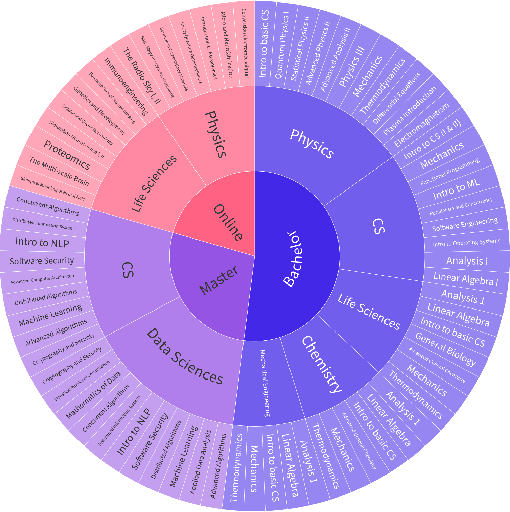
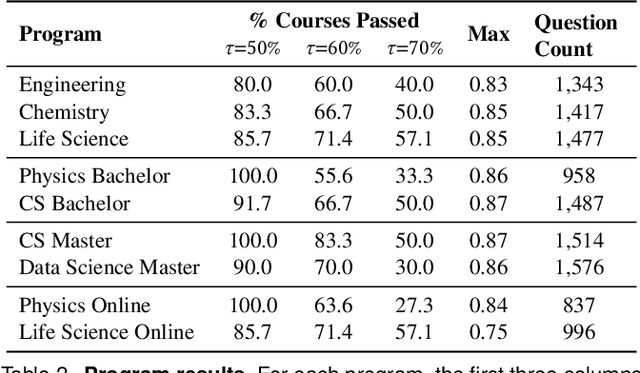

Abstract:AI assistants are being increasingly used by students enrolled in higher education institutions. While these tools provide opportunities for improved teaching and education, they also pose significant challenges for assessment and learning outcomes. We conceptualize these challenges through the lens of vulnerability, the potential for university assessments and learning outcomes to be impacted by student use of generative AI. We investigate the potential scale of this vulnerability by measuring the degree to which AI assistants can complete assessment questions in standard university-level STEM courses. Specifically, we compile a novel dataset of textual assessment questions from 50 courses at EPFL and evaluate whether two AI assistants, GPT-3.5 and GPT-4 can adequately answer these questions. We use eight prompting strategies to produce responses and find that GPT-4 answers an average of 65.8% of questions correctly, and can even produce the correct answer across at least one prompting strategy for 85.1% of questions. When grouping courses in our dataset by degree program, these systems already pass non-project assessments of large numbers of core courses in various degree programs, posing risks to higher education accreditation that will be amplified as these models improve. Our results call for revising program-level assessment design in higher education in light of advances in generative AI.
 Add to Chrome
Add to Chrome Add to Firefox
Add to Firefox Add to Edge
Add to Edge